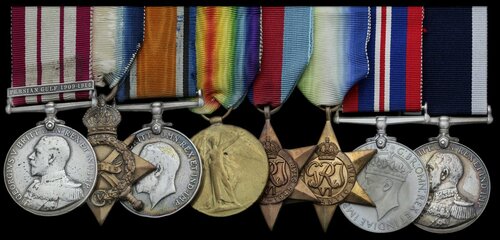
Auction: 21003 - Orders, Decorations and Medals
Lot: 311
(x) Eight: Chief Petty Officer A. Stagg, Royal Navy, who served on 'Q-Ships' during the Great War and earned a 'mention' for service with D.E.M.S. during the Second World War
Naval General Service 1915-62, 1 clasp, Persian Gulf 1909-1914 (J.15825 A. Stagg, Ord. Sea. H.M.S. Swiftsure.); 1914-15 Star (J.15825, A. Stagg, A.B. R.N.); British War and Victory Medals (J.15825 A. Stagg. L.S. R.N.); 1939-45 Star; Atlantic Star; War Medal 1939-45, with M.I.D. oak leaf; Royal Navy L.S. & G.C., G.V.R. (J.15825 A. Stagg. P.O., H.M.S. Royal Oak.), first four and last worn, thus nearly very fine (8)
Alfred Stagg was born at Ballycastle, County Mayo on 26 August 1896. His family moved to England shortly afterwards, residing on George Street, Hastings. Entering the Royal Navy on 12 February 1912, Stagg first served aboard Ganges, being transferred to Swiftsure on 2 July 1913. He was made Ordinary Seaman on 15 March 1914 and Able Seaman on 9 November 1914. From 27 January-4 February 1915, the Swiftsure helped to defend the Suez Canal near Kantara during the first Ottoman offensive. She became part of the Dardanelles Squadron on 28 February 1915, taking part in the Gallipoli Campaign. Stagg then served aboard Endymion from 8 January 1916.
Volunteering for service aboard Q-Ships, Stagg joined the crew of Acton on 1 April 1917. Renamed Q-34, this converted cargo ship (also named Wellington and Gandy) was credited by German sources with sinking the UC-72 in Bay of Biscay on 20 August 1917. Stagg was promoted Leading Seaman on 1 September 1918.
Stagg latterly took part in the Allied Intervention in Russia by serving aboard Sportive, which helped to evacuate White Russian forces from Odessa. Placed under Lieutenant-Commander Knox-Little, Sportive heroically entered a minefield to rescue survivors of the Manuel Balmo after she struck mines on 31 March 1919. In appalling weather conditions, Sportive continued to assist White Russians along the Black Sea coast through the winter, even being attacked by Red aeroplanes. She withdrew to Alexandria on 7 June 1920.
Stagg served over two years aboard Royal Oak from 12 May 1927, and was involved in the infamous Mutiny on 12 January 1928. This incident caused great controversy and embarrassment at the time. On 9 September 1929 he earned his L.S. & G.C., serving aboard Tarantula (an Insect Class Gunboat) on the China Station in 1933, finally being shore pensioned on 25 August 1936.
Stagg was recalled as Chief Petty Officer to President 3 on 24 August 1939. This was the accounting base for Defensively Equipped Merchant Ships or 'D.E.M.S.' during the Second World War. It was here that pay records were maintained for those sailors who were serving as gunners aboard Merchant Ships. Stagg was mentioned in dispatches for D.E.M.S. work, likely as a training instructor (London Gazette, 2 June 1943 refers). He received another War Gratuity, and was discharged on 14 September 1945; sold with copied research.
Subject to 5% tax on Hammer Price in addition to 20% VAT on Buyer’s Premium.
Sold for
£420
Starting price
£110




